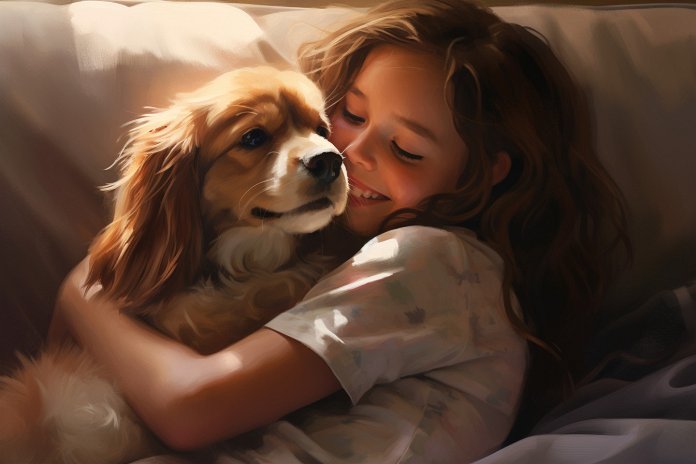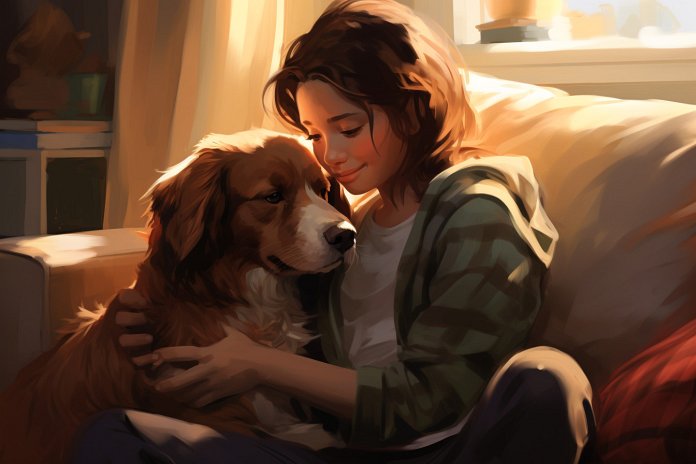
Dogs have been our companions for centuries and have learned to understand our behavior. They can even be trained as service dogs for people with disabilities. But can dogs understand what a hug means?
When you hug your dog, pay attention to their reaction.
Some dog owners claim that their dogs love hugs, while others believe that dogs become stressed or agitated when hugged. Here are some signs to look for when hugging your dog:
– Tail wagging:
A slow, stiff wag means your dog is alert, not necessarily happy. Tucking their tail and wagging indicates submission and nervousness. Happy tail wagging is energetic and combined with other signs.
– Ear position:
Dogs change the shape and position of their ears based on their mood. Forward and upward ears can indicate aggression or interest, while flat and pulled back ears show submission and fear.
– Staring:
If your dog looks away from you and you see the whites of their eyes, they are not enjoying the hug. They are enduring it.
– Growling:
A growl is a clear sign that the dog feels threatened and is not enjoying the hug. Never hug a dog that growls, as it can lead to serious injuries.
Body Language
Other signs that indicate a dog is not liking a hug include growling, staring, wagging their tail, dropped ears, ears back, and ears up. Signs that a dog does enjoy a hug include excited tail wagging, not shying away, hugging back on command, and showing calm body tension.
History of Dog Hugging
From an evolutionary perspective, dogs shouldn’t have a preference for hugs. Their ancestors didn’t tolerate being overwhelmed by other pack members. Dogs have an instinct to run away when scared or endangered. Hugs are controversial because they take away a dog’s freedom of movement, making them nervous or anxious.
Science of Dogs Sensing Hugs
A widely reported opinion editorial claimed that dogs hate hugs based on analyzing pictures of dogs being hugged. However, this wasn’t a study and lacked peer review. Scientists and behaviorists encourage dog owners to learn their dog’s behavioral cues to determine if they are stressed or relaxed.
Training Dogs to Become More “Huggable”
Some dogs don’t mind hugs, but their reaction may differ with strangers. Training can help make a dog more receptive to touch, especially if they need to be comfortable around children or in certain situations. Service dogs are trained to tolerate touching to assist their owners.
To train your dog to be more receptive to touch, take it slow, avoid training with children initially, start with simple stroking, and use crate training if appropriate. Remember to look for signs of stress when hugging your dog, as their comfort level may differ from ours.
“Understanding your dog’s body language is key to knowing whether they enjoy a hug or not.”

Tips & Things to Know
1️⃣ Pay attention to your dog’s body language: When hugging your dog, observe their tail wagging, ear position, and where they are looking. Signs such as slow tail wagging, flat ears, and looking away with whites of the eyes can indicate that they are not enjoying the hug and may be feeling stressed or anxious.
2️⃣ Understand that not all dogs enjoy hugs: While some dogs may tolerate or even enjoy hugs, many dogs may feel restricted or overwhelmed by the physical contact. It’s important to respect your dog’s individual preferences and comfort level when it comes to hugging.
3️⃣ Train your dog to be receptive to touch: If you want to teach your dog to be more comfortable with hugs or other forms of touching, start by taking it slow and gradually introducing more pressure. Avoid training with children initially and consider crate training to help with any fear of confinement. Look for signs of stress during training and adjust accordingly to ensure your dog’s well-being.
Frequently Asked Questions, Answered ✅
1. Can dogs understand what a hug means?
– The text suggests that dogs may not have a natural preference for hugs, but some may tolerate or even enjoy them.
2. How can you tell if a dog enjoys being hugged?
– Signs to look for include excited tail wagging, not shying away, hugging back on command, and showing calm body tension.
3. Why are hugs a controversial topic when it comes to dogs?
– Hugs can take away a dog’s freedom of movement, making them feel nervous or anxious. Additionally, their evolutionary instincts prompt them to run away or fight if feeling scared or endangered.
4. Was there a scientific study that concluded dogs dislike hugs?
– The text clarifies that the widely reported study was actually an opinion editorial based on analyzing pictures of dogs being hugged. It was not peer-reviewed and lacked detailed information on data gathering.
5. Can dogs be trained to be more receptive to touch, including hugs?
– Yes, training can help dogs become more comfortable with touch. Taking it slow, starting with simple stroking, avoiding training with children initially, and crate training can be helpful in this process. However, it is important to look for signs of stress in dogs during hugs.